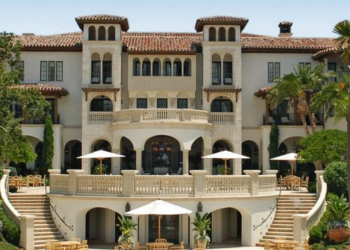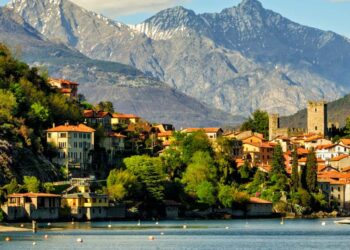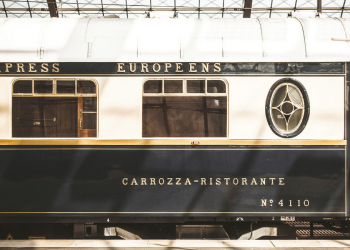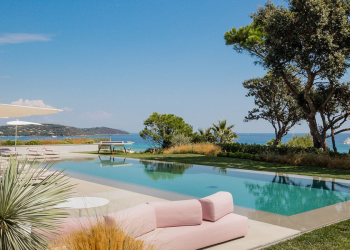We’re obsessed with restaurants like never before. Every time a new “best of” list drops or a Michelin guide is updated, a certain subset of passionate travelers and eaters will make their reservations and book their flights to Copenhagen, Lima, or Modena, Italy.
Many of these coveted dining destinations are in big cities, but sometimes they’re in the middle of nowhere, meaning those gastronomes have to be even more committed — but the sweet spot is when those restaurants also have accommodations. They aren’t so much hotels with good restaurants as they are outstanding restaurants with good hotels attached.
Booking into one lets you stay longer, to understand the place and its history and terroir better, and to fully relax and enjoy the meal, knowing that you don’t have to drive anywhere and simply have to walk upstairs. And then, after a rest, you might get to indulge in the pleasures of a six-course breakfast.
Akelarre Pedro Subijana, Spain
On the slopes of Mount Igueldo in San Sebastián, Akelarre is one of very few Michelin three-star restaurants — an honor it has had since 2007 — with a hotel. And the hotel is no mere afterthought. The light and airy rooms have ocean views, seating areas and desks, and furnished terraces; the Akelarre Suite also features an indoor-outdoor plunge pool. As for the main event, chef-owner Pedro Subijana and his team turn out inventive tasting menus — one includes a dish of stardust, laminated asparagus, mushrooms, and egg — in a handsome dining room overlooking the sea. The place also has a kitchen classroom that’s used mostly for experimentation (the staff includes a head of R&D) but can also hold master classes for small groups of interested diners.
Burg Schwarzenstein, Germany
A heritage-protected castle among the vineyards of the Rheingau — one of the best regions in the country for rieslings — Burg Schwarzenstein aims to blend tradition and modernity. The castle’s seven hotel rooms are individually decorated, while the 40 rooms in the park residence are little-filled oases of smart luxury. At the Burgrestaurant (castle restaurant), host Tim Buchmann and chef de cuisine Marco Stenger treat guests to memorable meals focused on regional ingredients and wines from nearby producers. The well-edited menu has plenty of options — from burrata with green asparagus and Datterino tomato, to Berlin-style calf’s liver with potato purée, apple, and onions — without being overwhelming. And in the springtime, white asparagus season, there’s a special menu devoted to the delectable vegetable.
Château de la Treyne, France
This 17th-century castle-turned-hotel on a river bank in the Dordogne region is a fantastical place that transports guests to another era. It’s a place of warm-hued marble, fabric wall coverings, original fireplaces, elaborate table settings, lavish flower arrangements, and 17 individually designed rooms with features like red brocade walls and gold-colored freestanding bathtubs. As for the restaurant, chef Stéphane Andrieux has been here for nearly 25 years, and he continues to outdo himself with inventive takes on the region’s many delicacies, such as truffles, Quercy lamb, Aubrac beef, and wild pigeon and duck. His presentation of foie gras remains a classic, as does his green asparagus, raw and cooked on their pulp with truffle sauce.
Château Neercanne, Netherlands
The only terraced castle in the Netherlands, Château Neercanne is known for its fine dining restaurant of the same name and its popular lunch spot, l’Auberge. Chef de cuisine Robert Levels and his team prepare a French cuisine with worldwide influences that combine local and international flavors. (And it’s refreshing to find a chef who is unapologetically international during these hyperlocal days.) Much of the produce comes from the estate garden and nearby farms, and there are standalone vegetarian and vegan menus as well as the usual omnivore version, which can all be paired with wines or alcohol-free cocktails. There are a handful of guest rooms in the old gatehouse, which have tremendous views over Belgium and the Netherlands and are a fine base for metabolizing a lavish dinner with a long morning walk in the forest.
Les Hautes de Loire, France
Deep in the Loire Valley, this 19th-century hunting lodge is now a Relais & Châteaux hotel and a palace of good living. In 2020, chef Dominique Pépin took over the stoves after working beside chef Rémy Giraud for many years. He continued in the same neoclassical French vein while adding personal touches and a modern twist. The luxurious French classics are well represented in hare terrine à la royale, eel salad, and Solonge caviar, but there’s also a lighter potager menu featuring vegetables from the hotel’s garden. Upstairs, the guest rooms are spacious and bright, with a sophisticated old-world feel about them.
Hisa Franko, Slovenia
This gastronomic destination might be new to some, but its history goes back 50 years, to when Valter Kramer’s father, Franko, served English roast beef in the house where Ernest Hemingway may (or may not) have written A Farewell to Arms. Now Valter’s wife, Ana Ros — one of the most admired chefs in the world — is the star of the show, although she would be quick to say that the products of the lush and remote Soca Valley are the stars of the show. Her restaurant is closely knit with the community of foragers, shepherds, cheese makers, hunters, and fishermen in the area. When you eat her food, she wants you to close your eyes and understand the environment that the restaurant is part of. Now, Valter is involved in the hospitality side but primarily focuses on making aged Tolminc cheese and collecting, producing, and pouring natural wines
Palazzo Seneca, Italy
Run by a local hospitality family since 1850, this 16th-century palace hotel puts history at the center of everything. It was built by an aristocratic family from Piedivalle, a town whose residents were known as skilled wood carvers, and that legacy is everywhere in the hotel, along with the work of the best Umbrian craftsmen. The 40 rooms have antique furnishings and a luxurious amount of space. Proprietor Federico Bianconi describes himself and his brother, Vincenzo, as “restaurant owners with rooms,” and the restaurant, Vespasia, lives up to that promise. It has two chefs, Fabio Cappiello, who is from Puglia, and Fumiko Sakai, who was born in Japan and has spent the past 20 years working beside Italian chefs. They bring a broad perspective to their cuisine, which includes dishes like crawfish with saffron risotto and prawn dashi, and ramen with mushrooms and ham consommé.
Rosa Alpina, Italy
High in the Dolomites, chef Norbert Niederkofler is probably the only chef in Italy who doesn’t use olive oil or lemon. Rather, he is deeply committed to his “cook the mountain” philosophy and has found an array of creative solutions involving fermenting and preserving local ingredients. His kitchen was practicing whole animal butchery before it was cool, and he now holds a Michelin green star for sustainability as well as three of the regular kind at his restaurant inside the Rosa Alpina hotel, St. Hubertus. That alone is worth booking a flight to Venice, but there’s more (not to mention the gorgeousness of the hotel itself). On summer Sundays, they offer a “St. Hubertus Unplugged” lunch service at the hotel owners’ private mountain hut, and Niederkofler also launched a project called AlpiNN, atop the Kronplatz ski area, where he invites like-minded chefs to collaborate on special dinners and offers a regular lunch service of “Cook the Mountain” dishes.
Taubenkobel, Austria
Years ago, Eveline and Walter Eselböck’s Taubenkobel was a well-known restaurant and hotel in eastern Austria. But times change, and now their daughter, Barbara Eselböck, and her husband, chef Alain Weissgerber, have turned it into something that’s both radically new and radically traditional. For 30 years, they’ve been collecting the wild herbs from around Lake Neusiedl, and working to recreate lost tastes as well as inventing new ones, based on the plants and animals of the region. The tasting menu spans a dozen courses and changes frequently, with the only requirement being that you can close your eyes while eating and know exactly where you are. Barbara looks after the hospitality, and her parents are still involved, particularly on the wine side, as they were champions of natural wine long before it became trendy. The hotel rooms, designed by Walter, are spacious, with rustic touches and a few whimsical details.
Vila Joya, Portugal
Chef Dieter Koschina’s Vila Joya was the first restaurant in Portugal to be awarded two Michelin stars, back in 1999. It’s held onto them ever since, with a menu that changes daily, making the most of local products (especially fish and seafood), in a dining room with a front-row seat on the Atlantic Ocean in the Algarve. The menu is compact, with just four courses, and might include dishes like langoustine with heart of palm and dashi vinaigrette, and skate wing with raisin and artichoke. The hotel is likewise compact, with just four rooms and nine suites in what feels like the private villa that it was originally meant to be, with sea views, and in some cases, sun terraces, private gardens with pools, and Jacuzzis on the terrace.







